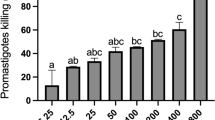Abstract
Aloe vera has wide spread use in health products, and despite several reports on the whole plant and inner gel, little work has been performed on the leaf exudate. Our aim was to evaluate the in vitro efficacy of Aloe vera leaf exudate (AVL) in leishmaniasis. Irrespective of the disease manifestation, promastigotes from strains responsible for cutaneous, mucocutaneous, and visceral leishmaniasis were susceptible to AVL and their IC50 ranged from 100 to 180 μg/ml. In axenic amastigotes cultured from a L. donovani strain 2001 responsible for visceral leishmaniasis, the IC50 was 6.0 μg/ml. AVL caused activation of host macrophages evident by an increased release of members of reactive oxygen species that was attenuated by preincubation with free radical scavengers. Collectively, our data indicates that AVL, via its direct leishmanicidal activity which can be further enhanced by activation of host macrophages, is an effective antileishmanial agent meriting further pharmacological investigations.



Similar content being viewed by others
Abbreviations
- AVL:
-
Aloe vera leaf exudate
- BSA:
-
Bovine serum albumin
- CL:
-
Cutaneous Leishmaniasis
- DMSO:
-
Dimethyl sulfoxide
- FBS:
-
Fetal bovine serum
- H2DCFDA:
-
2’, 7’-dichlorodihydrofluorescein diacetate
- IC50 :
-
50% inhibitory concentration
- L-NAME:
-
Nω-L-arginine Methyl Ester
- MCL:
-
mucocutaneous Leishmaniasis
- Medium A:
-
RPMI 1640 (without phenol red) with 10 % FCS and 100 μg/ ml gentamycin
- MTT:
-
3-(4, 5-dimethylthiazol-2-yl)-2, 5-diphenyl tetrazolium bromide
- NO:
-
Nitric oxide
- PBS:
-
Phosphate buffered saline (pH 7.4)
- ROS:
-
Reactive oxygen species
- SAG:
-
sodium antimony gluconate
- SOD:
-
superoxide dismutase
- VL:
-
Visceral Leishmaniasis
References
Desjeux, P.: Leishmaniasis: Current situation and new perspectives. Comp. Immunol. Microbiol. Infect. Dis. 27, 305–308 (2004)
Sundar, S., Sinha, P.R., Agarwal, N.K., et al.: A cluster of cases of severe cardiotoxicity among kala-azar patients treated with a high-osmolarity lot of sodium antimony gluconate. Am. J. Trop. Med. Hyg. 59, 139–143 (1998)
Guerin, P.J., Olliaro, P., Sundar, S., Boelart, M., Croft, S.L., Desjeux, P., Wasunna, M.K., Bryceson, A.D.: Visceral Leishmaniasis: Current status of control, diagnosis and treatment and a proposed research and development agenda. Lancet. Infect. Dis. 2, 494–501 (2002)
Sundar, S.: Drug resistance in Indian visceral leishmaniasis. Trop. Med. Int. Health. 6, 849–854 (2003)
Perez-Victoria, F.J., Castanys. S., Gamarro, F.: Leishmania donovani resistance to miltefosine involves a defective inward translocation of the drug. Antimicrob. Agents Chemother. 47, 2397–3303 (2003)
Akendengue, B., Ngou-Milama, E., Laurens, A., Hocquemiller, R.: Recent advances in the fight against leishmaniasis with natural products. Parasite. 6, 3–8 (1999)
Kayser, O., Kiderlen, A.F., Croft, S.L.: Natural products as antiparasitic drugs. Parasitol. Res. 90, S55-62 (2003)
World Health Organisation: A report of the consultation meetingon traditional and modern medicine: Harmonizing two approaches, 22–26 November 1999, Beijing, China., West Pacific Region (2000)
Ali, M.I., Shalaby, N.M., Elgamal, M.H., Mousa, A.S.: Antifungal effects of different plant extracts and their major components of selected Aloe species. Phytother. Res. 13, 401–407 (1999)
Ferro, V.A., Bradbury, F., Cameron, P., Shakir, E., Rahman, S.R., Stimson, W.H.: In vitro susceptibilities of Shigella flexneri and Streptococcus pyogenes to inner gel of Aloe barbadensis Miller. Antimicrob. Agents Chemother. 47, 1137–1139 (2003)
Reynolds, T., Dweck, A.C.: Aloe vera leaf-gel: A review update. J. Ethnopharmacol. 68, 3–37 (1999)
Debrabant, A., Joshi, M.B., Pimenta, P.F.P., Dwyer, D.M.: Generation of Leishmania donovani axenic amastigotes: Their growth and biological characteristics. Int. J. Parasitol. 34, 205–217 (2004)
Dutta, A., Bandyopadhyay, S., Mandal, C., Chatterjee, M.: Development of a modified MTT assay for screening antimonial resistant field isolates of Indian visceral leishmaniasis. Parasitol. Int. 54, 119–122 (2005)
Wan, C.P., Myung, E., Lau, B.H.: An automated micro-fluorometric assay for monitoring oxidative burst activity of phagocytes. J. Immunol. Methods. 159, 131–138 (1993)
Sereno, D., Lemesre, J.L.: Axenically cultured amastigote forms as an in vitro model for investigation of antileishmanial agents. Antimicrob. Agents Chemother. 41, 72–76 (1997)
Saar, Y., Ransford, A., Waldman, E., Mazareb, S., Amin-Spector, S., Plumbee, J., Turco, S.J., Zilberstain, D.: Characterization of developmentally-regulated activities in axenic amastigotes of Leishmania donovani. Mol. Biol. Parasitol. 95, 9–20 (1998)
Assreuy, J., Cunha, F.Q., Epperlein, M., Noronha-Dutra, A., O’Donell, C.A., Liew, F.Y., Moncada, S.: Production of nitric oxide and superoxide by activated macrophages and killing of Leishmania major. Eur. J. Immunol. 24 672–6 (1994)
Awasthi, A., Mathur, R.K., Saha, B.: Immune response to Leishmania infection. Indian J. Med. Res. 119, 238–58 (2004). Review.
Sudhandiran, G., Shaha, C.: Antimonial-induced increase in intracellular Ca2+ through non-selective cation channels in the host and the parasite is responsible for apoptosis of intracellular Leishmania donovani amastigotes. J. Biol. Chem. 278, 25120–25132 (2003)
Acknowledgments
The work received financial support from Council of Scientific & Industrial Research, Govt. of India, Life Sciences Research Board, DRDO, and Dept. of Biotechnology, Govt. of India. Avijit Dutta receives a Senior Research Fellowship from Indian Council of Medical Research. We gratefully acknowledge the receipt of strains from Dr. Vanessa Yardley, London School of Tropical Medicine and Hygiene, UK and Dr. Neeloo Singh, Central Drug Research Institute, Lucknow, India.
Author information
Authors and Affiliations
Corresponding authors
Rights and permissions
About this article
Cite this article
Dutta, A., Mandal, G., Mandal, C. et al. In vitro antileishmanial activity of Aloe vera leaf exudate: A potential herbal therapy in leishmaniasis. Glycoconj J 24, 81–86 (2007). https://doi.org/10.1007/s10719-006-9014-z
Published:
Issue Date:
DOI: https://doi.org/10.1007/s10719-006-9014-z




